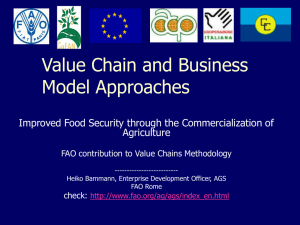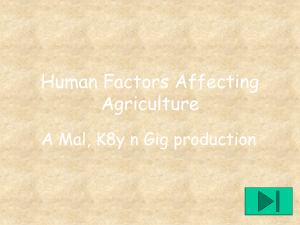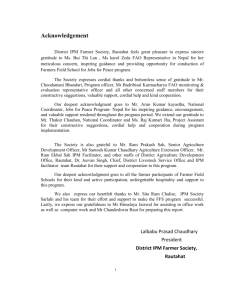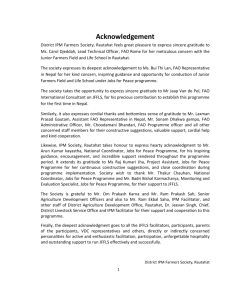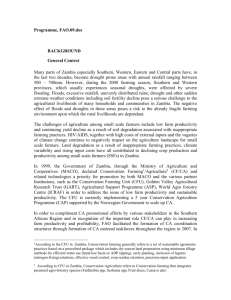Working Group 2 Conclusions - Food and Agriculture Organization
advertisement
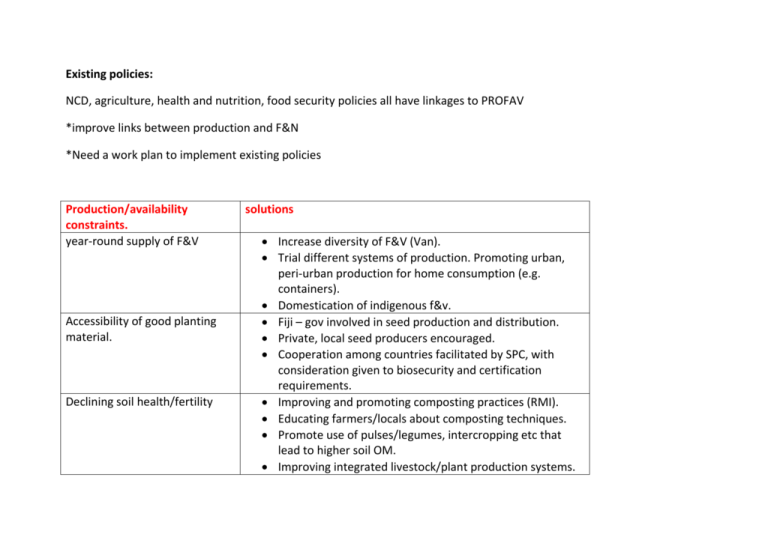
Existing policies: NCD, agriculture, health and nutrition, food security policies all have linkages to PROFAV *improve links between production and F&N *Need a work plan to implement existing policies Production/availability constraints. year-round supply of F&V Accessibility of good planting material. Declining soil health/fertility solutions Increase diversity of F&V (Van). Trial different systems of production. Promoting urban, peri-urban production for home consumption (e.g. containers). Domestication of indigenous f&v. Fiji – gov involved in seed production and distribution. Private, local seed producers encouraged. Cooperation among countries facilitated by SPC, with consideration given to biosecurity and certification requirements. Improving and promoting composting practices (RMI). Educating farmers/locals about composting techniques. Promote use of pulses/legumes, intercropping etc that lead to higher soil OM. Improving integrated livestock/plant production systems. Transportation, storage, Short shelf life/Lack of processing Lack of acceptance of local produce Improving cooperation/coordination among farmers. Gov to support transport (year-round) and construction of appropriate storage facilities. Collection centres. Creating local/village markets. Increase understanding among farmers on postharvest handling practices. Build capacity in villages. Provision of small-scale technologies. Re-introduce traditional knowledge on storing f&v. Educate local populations of nutritional value. Re-introduce knowledge of culinary/preparation use in local dishes. Improve convenience where possible (e.g. processing) Encourage local cuisines in local and tourist restaurants. Pest and disease Land availability Climate change/salinity Crop adaptability studies. R&D to develop saline and drought tolerant crops. Farming systems: container farming, hydroponics etc Extension/knowledge sharing of IPM approaches, including traditional methods and biological control Diversification, companion planting Promote GAP to avoid build up pesticide resistance strengthen regulatory use of pesticides enhance efficient use of agricultural land Farmer capacity (eg knowledge of IPM strategies) Low productivity Diversity of varieties Poor extension services Lack of coordination within promote backyard and front-yard/home gardening. Container/hanging gardening Foster greater extension via NGO’s, farmer organisations Using farmer field schools Tailoring extension to level of literacy/experience Demonstration/hands-on training Field days to “train the trainer” farmers – targeting lead farmers Farmer competitions Economics Market access information Covered above in GAP, training etc Incentives to encourage productivity. Long-term, strategic approach to crop breeding, selection of indigenous varieties etc Trial existing varieties Cooking shows and demonstrations, including via dieticians etc Proactive approach to commercialisation of local/traditional crops Increase ratio of extension officers to farmers Foster greater extension via NGO’s, farmer organisations Greater sharing of information/extension material among countries Improve information sharing/communication along the supply chain Infrastructure Lack of interest in ag/ poor resource use due to emigration of farmers value chain. Using communication devices (eg mobile phones) to improve information sharing to improve regular supply of produce Improve understanding of existing supply/value chains Improve supply of water to farms: miracles, desalinisation plants, water catchment systems, irrigation schemes, recycling. Harvesting rainwater. Coordinated transport *collection centres with storage facilities etc Government grants to encourage greater interest in ag Agriculture within curriculum (present in some schools and countries) Strengthen links between education and agriculture through career forums/expos Changing perception of ag from hard work with low pay to technology oriented and business driven Promote agriculture shows and awards Success stories/role models Country Vanuatu Priority plans Healthy school and correction service settings: Target “pilot” schools and surrounding communities (Peri-urban schools (focus on boarding schools) Provide diverse range of plant material and technical support to establish gardens and foster healthy eating habits. Target schools are primary and secondary Work with health and agriculture teachers Priority action agenda for government. – to reach 2016 “Healthy, Wealthy, Educated Vanuatu” Support conservation of OP seed lines Promote IPM vegetable production practices Establish breeding programme for local indigenous fruit trees. Stakeholders Government Departments Lead Dr. Roger Malapa Dept. of Public Health Dept. of Agriculture VARTC Dept. of Local Authorities Dept. Of Education Dept. of Biosecurity Local NGOs LLEE (Live & Learn Organisation) WSB (Wan Smol Bag Theatre) Farm Support Association Red Cross Care International ADRA WHO UNICEF UNDP Jean Jacques Rory/Nellie Muru Fernand Massing VTWG SPC FAO ACIAR Fiji RMI Health promoting primary schools. Educating population on nutritive value of indigenous vegetables/fruit using mass media. School gardens including vegetables and fruit trees NFNC WC FPAN SC HPS SC FT TAG NA DN FIND Nutrition CSN Health facilities FB HAG Cooking shows using local cuisines by SPC dieticians Establish fruit trees in hospital garden FAO ACIAR MOA Establish farming field schools MOE Through existing programme Farmer Association Consumer Council F&N policy developed next year for 2015. AMA PROFAV to fit within this policy area. FPAN 2016-2020 will include details of CLC programmes and activities of PROFAV. FBO Provincial structures Improving student understanding of MOH Ateca Kama Dr Isimeli Tukana Mr Ilimeleki, CE MPI Mr Tikiko Lewesi Dr Peter Hoejskov Mrs Jiutajia Tikoitoga Ms Ditoga Kabukeinamala Ateca Kama Mrs Jowalesi Taukei Shalendra Prasad Mr Tikiko Lewesi Josua Namoce Alifereti Yaya Charlynne A. Alfred/ Carlinda nutritional value of F&V and assessing learning outcomes using MISAT. This will include: Better utilisation of primary and secondary school gardens education and training of schools, pre and post MISAT assessments and health aspects cooking demonstrations – traditional knowledge in preparing and cooking indigenous fruit and veg. long term (order of priority) climate change (incl. pest and disease, salinity, ) promote home gardens capacity building farmers transportation (outer islands) and storage (shelf life) diversity infrastructure soil health and fertility Kiri Educate farmers on GAP making high quality composts R&D MOE EPA WUTMI YTYIH KUTMIT FBO MOFA NGOs Wellness Center MIEPI SPC FAO ACIAR Jabjulan Karness Kusto Glorina Harris/ Theresa Kijiner Abraham Hicking Kathryn Rilang Aluka Rakin Janet Nemra Aindrik George Ylissa Kendall Dr. Pinano Ray House May Ipil MELAD-Agriculture MOE-Curriculum section Tianeti Benna –OIC Director planting techniques. cultivation of swamp taro using traditional knowledge Postharvest Priority: Support ongoing research on drought and saline tolerant crops Provide tested planting material to farmers for commercial production Encourage farmers to capture rainwater by investing in infrastructure (water tanks) Demonstrate benefits of existing investments Support ongoing activity to establish local markets for farmers to sell produce Support school garden activities (long term) Coordination among stakeholders Barriers: Competing priorities, political interference MHMS-Nutrition section NGOs: KOP, LLE, TOFMA SPC FAO ACIAR Eretii Timeon Ahling Onorio, Iataake Totoki Mwamwarau Karirieta Regional coordination: SPC, UNICEF, WHO, FAO Sharing/dissemination of information among country representatives Facilitate technical assistance at a regional level Communication: Email network preferred over website. Potential to use FAO PROFAV website to provide relevant material from workshop. A one-pager brief to disseminate. Content: PROFAV purpose and benefits Good time to contact other relevant ministries so they can include PROFAV in their business plans Awareness raising: Linkage with world food day and in Fiji Food and Water day, world health day Financial incentives to encourage younger population to engage in ag in Fiji Responsibilities of national teams: Goal setting Developing indicators for project outcomes Incorporate PROFAV into business plans Raising Awareness Monitoring and evaluation


